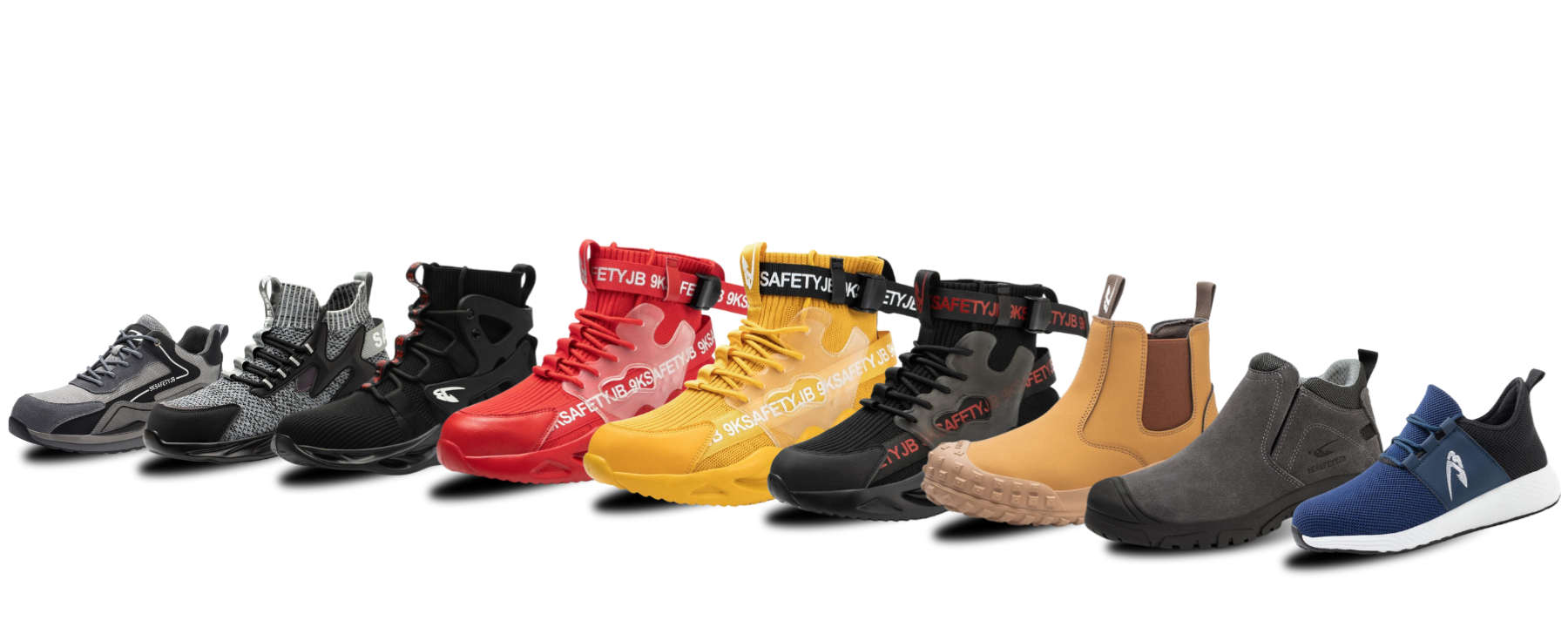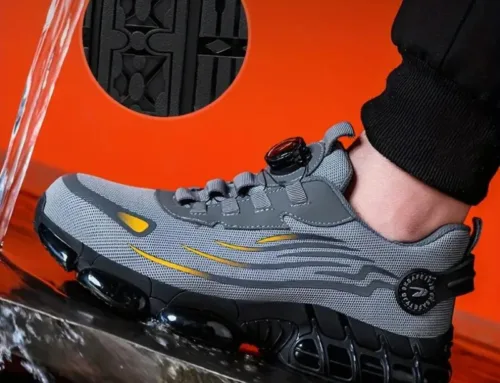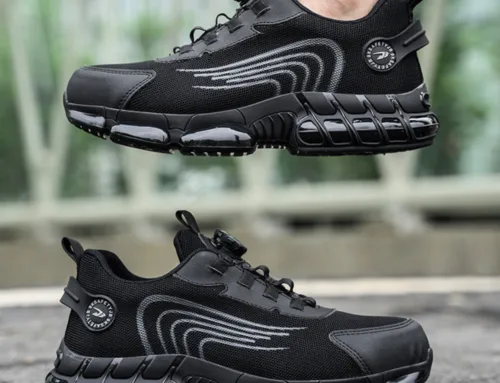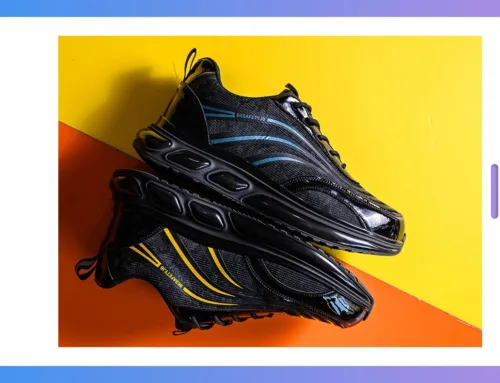Safety shoes are designed to protect your feet from different hazards depending on your work environment. Choosing the right pair for your activity is crucial to ensuring safety and comfort. Below, we’ll explore the most common types of safety shoes and which activities they’re best suited for, followed by a table outlining mandatory safety standards for these shoes.
Different Types of Safety Shoes for Various Activities
1. Steel-Toe Safety Shoes
Best For: Construction, heavy manufacturing, and metalwork.
- Description: Steel-toe shoes are perhaps the most well-known type of safety footwear. They have a reinforced steel toe cap to protect against heavy objects or crushing hazards.
- Protection Against: Falling or rolling objects, compression.
2. Composite-Toe Safety Shoes
Best For: Electrical work, outdoor jobs, and extreme temperature environments.
- Description: These shoes use a composite material instead of steel to offer toe protection. While they provide similar protection, they are lighter and non-metallic, making them ideal for workers who need to avoid metal detectors or those who work in environments with electrical risks.
- Protection Against: Falling objects, extreme cold or heat, electrical hazards.
3. Electrical Hazard (EH) Safety Shoes
Best For: Electricians, utility workers, and engineers.
- Description: Designed to protect against electrical hazards, EH-rated shoes have non-conductive soles and heels that reduce the risk of electrical shocks.
- Protection Against: Electrical shocks up to 600 volts in dry conditions.
4. Puncture-Resistant Safety Shoes
Best For: Construction, warehousing, and jobs with sharp objects on the ground.
- Description: These shoes feature a puncture-resistant plate built into the sole to protect your feet from sharp objects like nails or glass.
- Protection Against: Punctures from sharp materials on the ground.
5. Slip-Resistant Safety Shoes
Best For: Kitchens, hospitals, and any wet or oily environments.
- Description: Designed with special tread patterns and materials to improve grip, these shoes help prevent slipping on wet or oily surfaces.
- Protection Against: Slips and falls on wet or greasy floors.
6. Metatarsal Guard Safety Shoes
Best For: Foundries, metalworks, and places where heavy machinery or objects are handled.
- Description: These shoes provide protection not only to the toes but also to the top of the foot. A metatarsal guard is added to protect against impact and compression on the upper foot.
- Protection Against: Impact and compression on the entire foot, not just the toes.
7. Waterproof Safety Boots
Best For: Outdoor work, especially in wet or rainy conditions.
- Description: Waterproof boots keep your feet dry and comfortable, even in wet conditions, while offering other safety features like toe protection or slip resistance.
- Protection Against: Water penetration, slippery surfaces.
8. Heat-Resistant Safety Shoes
Best For: Foundries, welding, and hot environments.
- Description: These shoes are built with materials that can withstand extreme heat without compromising safety.
- Protection Against: Heat exposure and burns.
9. Cold-Resistant Safety Boots
Best For: Outdoor work in cold climates, such as snow, ice, or refrigerated environments.
- Description: These boots are insulated to keep your feet warm in extremely cold conditions while also providing protection from impacts and other hazards.
- Protection Against: Frostbite, cold-related injuries, and typical work hazards.
10. ESD (Electrostatic Dissipative) Safety Shoes
Best For: Electronics manufacturing, cleanrooms, and areas with sensitive electronic equipment.
- Description: ESD shoes help discharge static electricity in a controlled manner, reducing the risk of damaging sensitive equipment or igniting flammable materials.
- Protection Against: Electrostatic discharge, which can cause equipment damage or fires.
Table of mandatory standards for different types of safety shoes
| Standard | Description | Mandatory For |
|---|---|---|
| EN ISO 20345 | General standard for safety footwear in Europe, specifying basic requirements like toe protection. | All safety shoes sold in Europe. |
| ASTM F2413 | North American standard for protective footwear, outlining minimum requirements for toe impact and compression. | Steel-toe and composite-toe shoes in North America. |
| CSA Z195 | Canadian standard for protective footwear, similar to ASTM F2413 but with additional requirements for cold resistance. | Safety shoes in Canada. |
| S1P (EN 20345) | Provides basic toe protection and anti-static properties, with additional puncture resistance and closed heel. | Industrial environments in Europe. |
| S3 (EN 20345) | Includes all S1P standards, plus waterproof properties. | Outdoor construction, agriculture, and logistics. |
| EH (Electrical Hazard) | Shoes must protect against electrical shock up to 600 volts. | Electrical workers and environments with electrical risks (ASTM F2413). |
| Slip Resistance (SRC) | Footwear must pass slip tests on both wet and oily surfaces. | Kitchens, hospitals, oil and gas industries. |
| P (Puncture Resistant) | Ensures that the sole can resist punctures from sharp objects like nails or glass. | Construction, warehousing, and industrial settings. |
| HRO (Heat Resistance) | Footwear must withstand high temperatures (up to 300°C) without compromising safety. | Welding, foundries, and other high-heat environments. |
| CI (Cold Insulation) | Provides insulation against cold environments, keeping feet warm. | Cold storage, outdoor work in freezing conditions. |
| WR (Waterproof) | Ensures that shoes are resistant to water penetration. | Outdoor environments, waterworks, and rainy conditions. |
| ESD (Electrostatic Dissipation) | Protects against electrostatic build-up by dissipating charges safely. | Electronics manufacturing, cleanrooms, and chemical industries. |
Each type of safety shoe serves a specific purpose based on the work environment and potential hazards. From steel-toe shoes to ESD footwear, selecting the correct pair ensures that workers stay safe, comfortable, and compliant with mandatory safety standards.





Leave A Comment